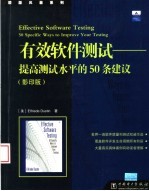
- 作 者:(美)达斯汀著
- 出 版 社:北京:中国电力出版社
- 出版年份:2004
- ISBN:7508310543
- 标注页数:258 页
- PDF页数:271 页
请阅读订购服务说明与试读!
订购服务说明
1、本站所有的书默认都是PDF格式,该格式图书只能阅读和打印,不能再次编辑。
2、除分上下册或者多册的情况下,一般PDF页数一定要大于标注页数才建议下单购买。【本资源271 ≥258页】
图书下载及付费说明
1、所有的电子图书为PDF格式,支持电脑、手机、平板等各类电子设备阅读;可以任意拷贝文件到不同的阅读设备里进行阅读。
2、电子图书在提交订单后一般半小时内处理完成,最晚48小时内处理完成。(非工作日购买会延迟)
3、所有的电子图书都是原书直接扫描方式制作而成。
1.Requirements Phase 1
Item 1:Involve Testers from the Beginning 3
Item 2:Verify the Requirements 5
Item 3:Design Test Procedures As Soon As Requirements Are Available 11
Item 4:Ensure That Requirement Changes Are Communicated 15
Item 5:Beware of Developing and Testing Based on an Existing System 19
2.Test Planning 23
Item 6:Understand the Task At Hand and the Related Testing Goal 25
Item 7:Consider the Risks 31
Item 8:Base Testing Efforts on a Prioritized Feature Schedule 39
Item 9:Keep Software Issues in Mind 41
Item 10:Acquire Effective Test Data 43
Item 11:Plan the Test Environment 47
Item 12:Estimate Test Preparation and Execution Time 51
3.The Testing Team 63
Item 13:Define Roles and Responsibilities 65
Item 14:Require a Mixture of Testing Skills,Subject-Matter Expertise,and Experience 75
Item 15:Evaluate the Tester's Effectiveness 79
4.The System Architecture 91
Item 16:Understand the Architecture and Underlying Components 93
Item 17:Verify That the System Supports Testability 97
Item 18:Use Logging to Increase System Testability 99
Item 19:Verify That the System Supports Debug and Release Execution Modes 103
5.Test Design and Documentation 107
Item 20:Divide and Conquer 109
Item 21:Mandate the Use of a Test-Procedure Template and Other Test-Design Standards 115
Item 22:Derive Effective Test Cases from Requirements 121
Item 23:Treat Test Procedures As"Living"Documents 125
Item 24:Utilize System Design and Prototypes 127
Item 25:Use Proven Testing Techniques when Designing Test-Case Scenarios 129
Item 26:Avoid Including Constraints and Detailed Data Elements within Test Procedures 135
Item 27:Apply Exploratory Testing 139
6.Unit Testing 143
Item 28:Structure the Development Approach to Support Effective Unit Testing 145
Item 29:Develop Unit Tests in Parallel or Before the Implementation 151
Item 30:Make Unit-Test Execution Part of the Build Process 155
7.Automated Testing Tools 159
Item 31:Know the Different Types of Testing-Support Tools 161
Item 32:Consider Building a Tool Instead of Buying One 167
Item 33:Know the Impact of Automated Tools on the Testing Effort 171
Item 34:Focus on the Needs of Your Organization 177
Item35:Test the Tools on an Application Prototype 183
8.Automated Testing:Selected Best Practices 185
Item 36:Do Not Rely Solely on Capture/Playback 187
Item 37:Develop a Test Harness When Necessary 191
Item 38:Use Proven Test-Script Development Techniques 197
Item 39:Automate Regression Tests When Feasible 201
Item 40:Implement Automated Builds and Smoke Tests 207
9.Nonfunctional Testing 211
Item 41:Do Not Make Nonfunctional Testing an Afterthought 213
Item 42:Conduct Performance Testing with Production-Sized Databases 217
Item 43:Tailor Usability Tests to the Intended Audience 221
Item 44:Consider All Aspects of Security,for Specific Requirements and System-Wide 225
Item 45:Investigate the System's Implementation To Plan for Concurrency Tests 229
Item 46:Set Up an Efficient Environment for Compatibility Testing 235
10.Managing Test Execution 239
Item 47:Clearly Define the Beginning and End of the Test-Execution Cycle 241
Item 48:Isolate the Test Environment from the Development Environment 245
Item 49:Implement a Defect-Tracking Life Cycle 247
Item 50:Track the Execution of the Testing Program 255
